Disaster prevention by dams in a new era20 July, 2021
In recent years, huge typhoons and localized torrential rains have been occurring frequently, and we often hear special warnings against such heavy rainfall. So, dam’s role of the disaster prevention function is becoming more and more important. Under the circumstances, movements to strengthen such a basic function of dams have begun for flood control, making use of existing dams.
In this special report, we will introduce the frontline flood control measures to be prepared for frequent heavy rain disasters.
“Pre-discharge” Use of water utilization capacity of a dam for flood control
There are three types of dams: "flood control dams" to prevent floods, "water utilization dams" to store water used for agriculture, domestic water supply, industrial use and power generation, etc. In addition, there are "multipurpose dams" with both functions. Therefore, “pre-discharge” is attracting attention now as an initiative to strengthen the flood control function by utilizing the water utilization capacity of water utilization dams and multipurpose dams. Pre-discharge means to discharge part of water stored in the dam for the original purpose of water utilization in advance when a heavy rain is predicted so as to increase the flood control capacity for storing rainwater. In response to a series of heavy rain-caused disasters such as Typhoon No. 19 in October of 2019 that caused enormous damage to eastern Japan, the flood damage mitigation system is being developed that enables advance water release from dams nationwide based on the policy set by the government.
Pre-discharge requires part of the water utilization capacity for flood control capacity, so it is necessary for water users, dam operators, and river administrators to discuss in advance and prepare the rules and the systems. So far, for 99 river systems with dams among class-A rivers nationwide, river administrators, dam operators, water users, etc. have signed the flood control agreements that set basic rules for pre-discharge for each water system. .. As a result, out of the sum of the effective storage capacities of dams nationwide, flood control capacity has increased from 30% (4.6 billion m3) to 60% (9.1 billion m3). Now they are working for reaching the agreement on class-B rivers.
Flood prevention operation by dams Now showing on our YouTube!
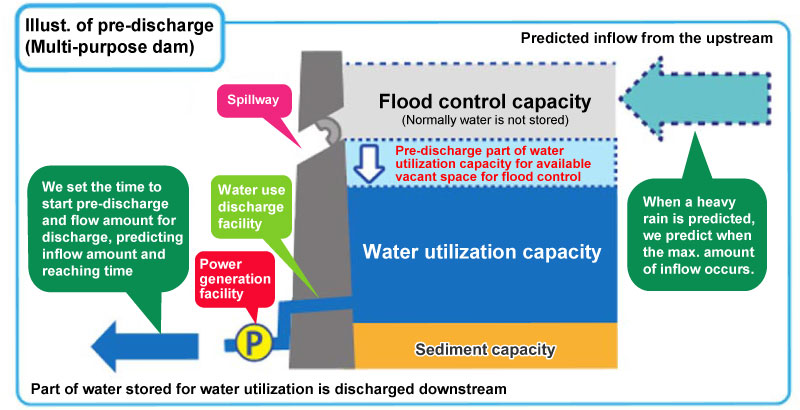
Illustration of pre-discharge
(in the case of a multi-purpose dam)
Technical terms for disaster prevention by dams
Flood control operation:
By storing the inflow water in the dam reservoir after discharging part of inflow water from the dam, the water level of the river downstream is kept adequately low. Such operation is called flood control operation.
Disaster prevention operation at the time of extraordinary flood:
When predicting that the dam could reach the full capacity level due to extraordinary heavy rainfall, the dam operator releases the same predicted amount of water that would flow into the dam reservoir. Such operation is called disaster prevention operation at the time of extraordinary flood.
Pre-discharge operation:
In case extraordinary heavy rainfall is predicted, the dam operator discharge part of water stored for the purpose of water utilization prior to actual rainfall to lower the water level for flood control purpose. This operation is called pre-discharge operation.
On-site assistance with new technologies
Pre-discharge operation, which started thoroughly from 2020, requires difficult judgment for proper implementation. This is because the judgment criteria is heavily dependent on the accuracy of rainfall predictions. There are possibilities that insufficient pre-discharge could end up with reaching full reservoir level before rainfall stops and too much pre-discharge could result in insufficient recovery of reservoir water level before flood risk is gone.
While more advanced dam operation is required to minimize damage downstream of the dam, the Japan Water Agency's Water Resources Development Center is now working on the development of the system that uses the latest technologies to support dam disaster prevention on sites.
A new dam disaster prevention operation training simulator
The discharge from a dam is carried out to follow the rules such as the operation rules set by each dam. but in recent years heavy rains have caused us to require more detailed and fine-tuned judgment. Under the circumstances, we have developed a new "training simulator for dam disaster prevention operation" that allows us to take a higher perspective point of view for water level and flow rate upstrem and downstream of a dam and perform trainings to accurately operate the dam while predicting the impact on the rivers downstream.
The dam disaster prevention operation training simulator is a training device that simulates training so that appropriate discharge operation can be performed based on the operation rules while observing the inflow to the dam reservoir. It has been implemented in many dams so far. Since most of conventional simulators were used in the operation room with an equipped simulation board. So they could not be used during the actual dam discharge operation. In other words, there were problems in terms of frequency and timing of trainings that could be carried out.
On the other hand, the newly-developed simulator can be easily operated at any time on the staff's personal computer. Another major change is that after reflecting the flow rate conditions of the upstream and downstreams of dams caused by rain, the reproducibility is improved by changing the condition of the river downstream in conjunction with the discharge from the dam. Thanks to this change, it has become possible to train the staff in situations that are much closer to those situations during actual disaster prevention operations.
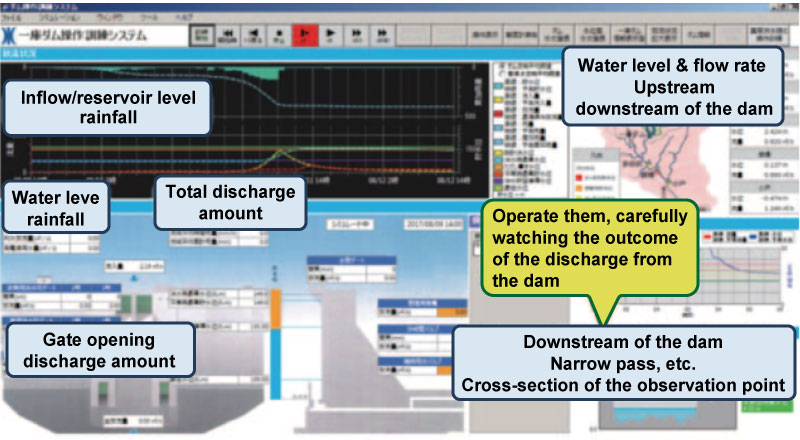
Main screen of the dam disaster prevention operation training simulator
Judgment can be made for disaster prevention operation, after grasping the rainfall and flow rate of the condition of upstream and downstream of a dam
Training with the use of the simulator
The Water Resources Engineering Department is conducting dam disaster prevention operation training using the newly developed simulator. With the new simulator, we can train the staff as if they are facing the actual situation with the simulated data taken from the actual inflow during the past floods on the computer. They can operate the equipment and learn how to handle dam’s disaster prevention operation. This equipment will enable us the enhanced training opportunities for the facility staffers.
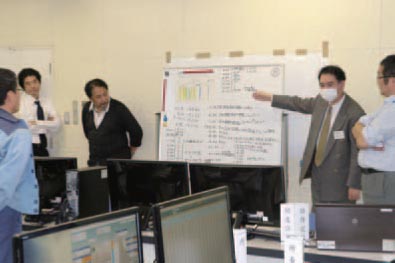
Dam’s disaster operation training
The training consists of a classroom lecture and practical training, and participants perform practical training using the dam disaster prevention operation training simulator based on the knowledge gained in the classroom lecture.
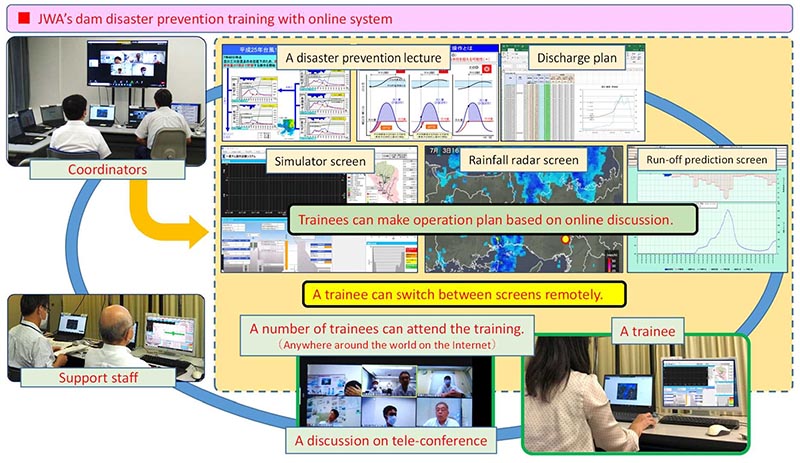
Remote training using tele-conference system
For example, for the training for managers who actually need to command dam operations, we are conducting training for them to formulate an optimal discharge plan as a team while observing the conditions of the basin such as the ever-changing predicted inflow. Some participants made the following comments, "It was a very meaningful training because I physically practiced disaster prevention operation that I had never experienced in a rea situation." And “It was quite effective because we upgraded our skills for disaster prevention operation, making its plan based on the discussions with other team members on the simulated scene”
From this year, we have also started remote training using the web conferencing system, connecting the Water Resources Engineering Department and a field office online.
Dam Disaster prevention operation support system
Dam disaster prevention operations are required to make predictions, meeting with the changes of the situations and make appropriate decisions, given the limited number of personnel and time constraints. The "Dam Disaster Prevention Operation Support System" was developed as a tool to support the determination of such dam operation policies.
This system automatically acquires various actual data on the dam such as reservoir level, inflow amount and discharge amount as well as predicted rainfall and runoff amount forecast every ten minutes and also it provides proposal plans, including a dam discharge plan, supporting explanation materials and proposed discharge notifications, and related communication documents. For example, one of the system functions is "Disaster prevention operation support function for abnormal flood time” It automatically calculates various patterns of discharge of indivudual dams based on the operation rules,the predicted rainfall amount and runlff prediction information, etc.. As we can make a discharge plan, we can have more time to discuss a more accurate dam operation policy than before.
In addition, linking this support system with the training simulator mentioned above allows us to build a system that can support more advanced and efficient dam management. In this system coordination process, sending data such as runoff prediction from the support system to the training simulator also allows us to carry pradctical training before actual flooding occurs.
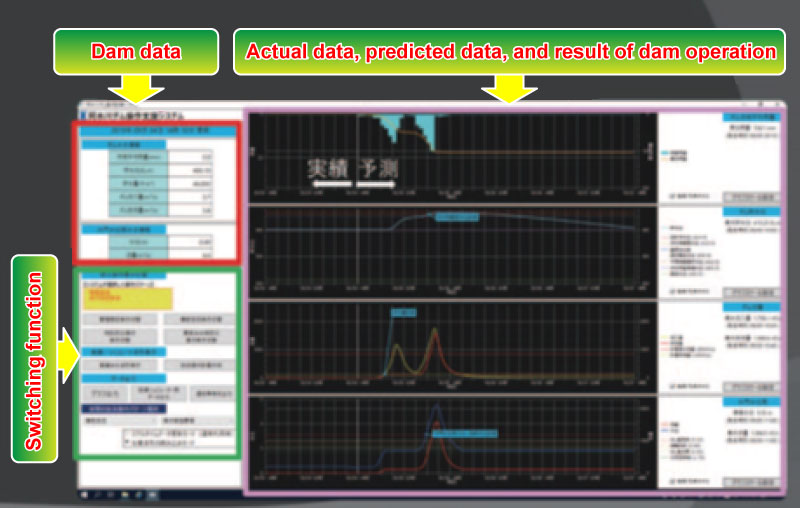
Dam disaster prevention operation support system screen
Future prospect

Mr. Tamura, ChiefWater Resources Engineering Dept..
Under the circumstances where more and more advanced operational skills are becoming necessary on site for dam disater prevention, we asked Chief Tamura Kazunori of Water Resources Engineering Department about future developments of technologies. His reply was, as follows:
"We make a point of operating the developed training simulator and support system in parallel and providing timely feedback. We are planning to introduce them to the dams that are in need of them in the future. Since trainings can be conducted remotely, we are planning to privide trainings to the staff being engaged in operation of local government-run dams as well as overseas engineers so that we can share the same advanced dam disaster prevention operations we have accumulated so far with them.


 Dam’s disaster operation training
Dam’s disaster operation training


